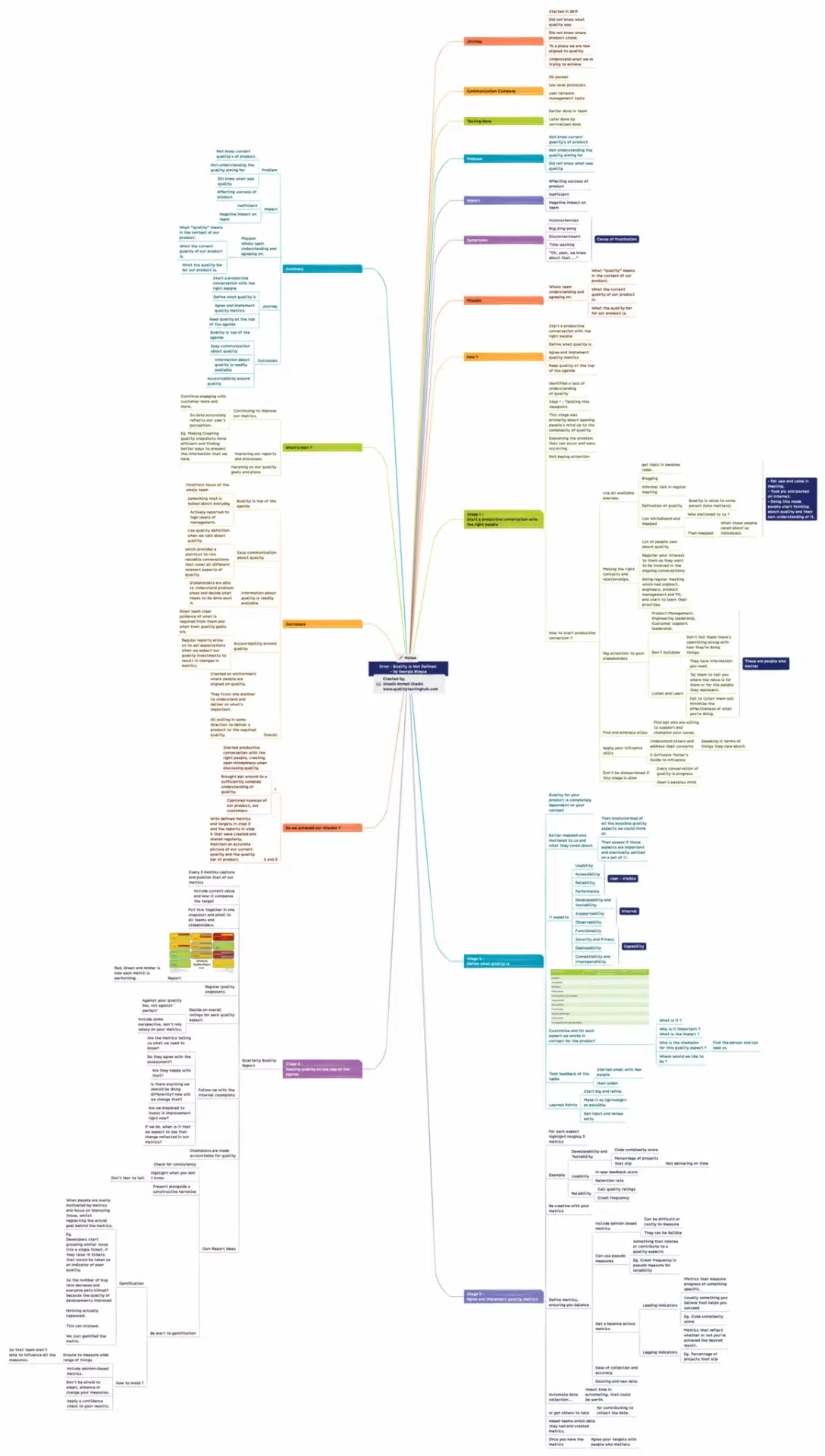Have you ever gotten confused and taken pause while working, thinking, What is quality? and the product does not aim for some defined quality? No worries, here is a perfect article for you where you get to know an amazing transformation from a place where no one knew what quality was to a place where quality is aligned successfully.
I created a piece below that discusses the quality journey.
Georgia talks about her journey after taking on the role of test owner for one of the company’s key products. She takes us on a quality journey in the talk, where she rapidly discovered that the team had little idea of the product’s present or desired quality. There was no clear grasp of what “quality” meant! Georgia then decides on a mission and started working on making the mission successful. She got her company to discuss quality and come up with a definition. and how they achieved team buy-in by agreeing on key quality indicators.
Let’s go through the journey.
Georgia started her journey in 2019 as a test owner in one of the company’s key products. At the beginning of the journey, she discovered that the team did not know what quality was, and where the product quality stood off the product.
Being a test owner she decided to note the problems to work on.
Problem: The team neither knew the current quality of the product, nor the understanding of where the quality aiming for. No one knew what quality was.
The impact of the problem was seen in how the product success is getting affected which was creating a negative impact on the team. She came on a Mission and started the journey to find a solution to the problem.
The mission was to make the Whole team understand and agree on
What does “quality” mean in the context of our product?
What the current quality of our product is?
What the quality bar for our product is?
To achieve a solution to the mission statement she defined 4 stages,
1. Start a productive conversation with the right people
2. Define what quality is
3. Agree and implement quality metrics
4. Keep quality at the top of the agenda.
Stage 1: Start a productive conversation with the right people.
This stage was primarily about opening people’s minds up to the complexity of quality. Explaining the problem that can occur and were occurring. To start the conversation below are the actions that were taken,
Utilize every route available: Getting the topic of Quality on people’s radars, Blogging about it. Informally talk in a regular meeting. She then used the whiteboard to map Who mattered to them? and then mapped what these people cared about as individuals.
Making the right contact and relationships: Learning about the priorities of different leads in the organization by attending the regular meeting which had Support, Engineers, Product Management, and PO.
Started paying attention to the stakeholders: Stakeholders have all the information you need. You should tell them to tell you where the value is for them or for the people they represent. Listen and Learn.
Find and embrace allies: Find people who are willing to support and champion your cause.
Apply influence skills: Speaking in terms of things people care about.
Every conversation is a quality process people should not be disheartened if the stage starts slow.
Stage 2: Define what quality is.
Quality for your product is completely dependent on your context. She started brainstorming all the possible aspects everyone could think of, assessed if these aspects were important, and then eventually selected a set of 11.
The 11 aspects were divided into 3 categories,
User – Visible
Usability
Accessibility
Reliability
Performance
Internal
Developability and testability
Supportability
Observability
Capability
Functionality
Security and Privacy
Deployability
Compatibility and interoperability.
A customized table was created with all the quality aspects, and for each aspect below things were written in the context of the product,
1. What is it?
2. Why is it important? What is the impact?
3. Who is the champion for this quality aspect? Find the person who can lead us.
4. What is our goal?
Stage 3: Agree and Implement quality metrics.
For each aspect, roughly 3 metrics were highlighted. For example, for developability and Testability: The code complexity score and Percentage of projects that slip (Not delivered on time) metric were defined.
To ensure the balance in defining the metrics few more metrics were included.
Opinion-based metrics: This can be difficult or costly to measure and can be fallible.
Pseudo measures: This is something that relates or contributes to a quality aspect. Eg. Crash frequency is the pseudo measure for reliability.
Get balance across metrics: Leading indicators and Lagging indicators were defined. The leading indicator is the metrics that measure the progress of something specific. The lagging indicator is the metric that reflects whether or not you have achieved the desired result.
To get the data for the metrics, Automate data collection, and also get others’ help for contributing to collecting the data it can be worth. Once you have the metrics agree on your targets with people who matter.
Stage 4: Keeping quality at the top of the agenda.
Quarterly Quality Report
Every 3 months the data of the metrics is captured and published which includes the current value and how it compares to the target.
All the aspect data is put together in one snapshot and emails to all teams and stakeholders are triggered. That is the quality report.
Red, Green, and Amber colors define how each metric is performing. To decide on overall ratings for each quality aspect some perspective was included, so we don’t rely solely on your metrics.
Follow up with internal champions on,
Are the metrics telling us what we need to know?
Do they agree with the assessment?
Are they happy with that?
Is there anything we should be doing differently? how will we change that?
Are we prepared to invest in improvement right now? If we do, when is it that we expect to see that change reflected in our metrics?
Champions are made accountable for quality.
Was the Mission Achieved ?
Started a productive conversation with the right people, creating open-mindedness when discussing quality brought people around to a sufficiently complex understanding of quality.
With defined metrics and targets in Stage 3 and the reports in Stage 4 that were created and shared regularly, maintain an accurate picture of our current quality and the quality bar of the product.
Successes
Quality is top of the agenda
Easy communication about quality
Information about quality is readily available
Accountability around quality
Overall: An environment was created where people are aligned on quality. They trust one another to understand and deliver on what’s important. All pulling in the same direction to deliver a product to the required quality.
What’s next?
Continuing to improve our metrics.
Improving our reports and processes.
Iterating on our quality goals and plans.
A summary of the talk is below,


